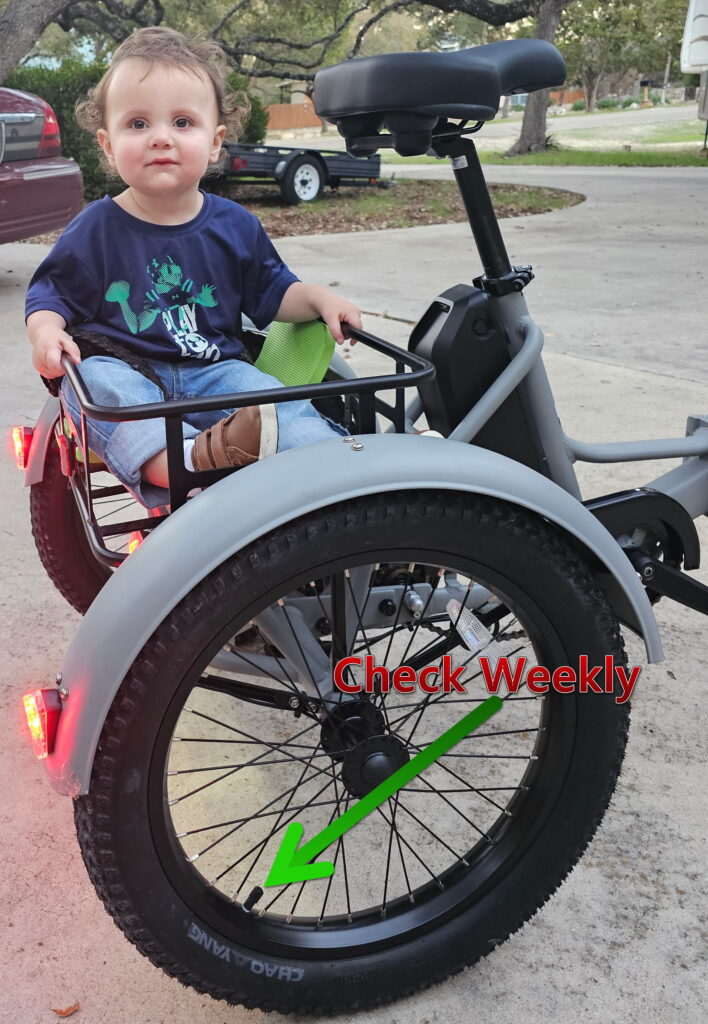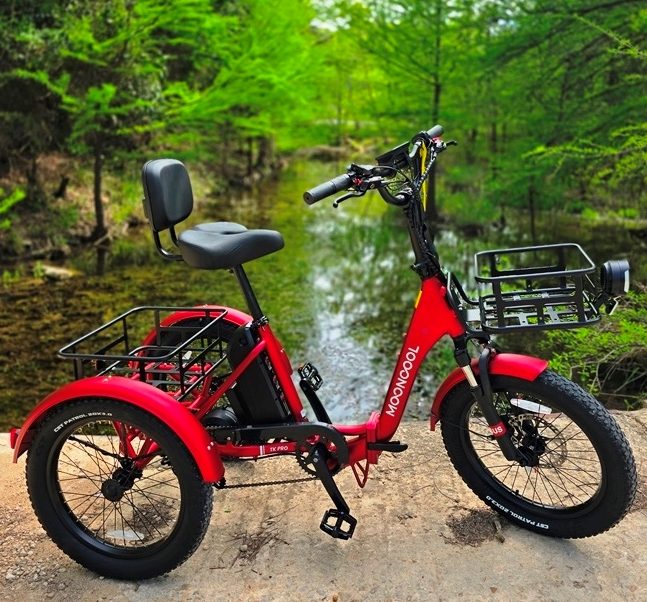E-trike fans tend to concentrate on the motor and battery, but don’t forget the tires! The wheel support, traction, and shock absorption provided by your tires are very important. Much of the benefit comes by maintaining proper tire pressure. But what is the best pressure for your fat tires?
It’s a much more complex issue for an e-trike than it is for an automobile. You probably know the approximate best pressure for your automobile tires, and you keep it close to that number year round. The tire manufacturer provides you with a recommended pressure, and there’s not a lot of leeway in that number.
When it comes to e-trike fat tires, things are different. There is a much broader range of acceptable tire pressures. You can make extensive adjustments without endangering the rider. The pressure can even be set differently for every ride, and you get to decide what’s best for the expected riding conditions and terrain. A few general guidelines can be helpful.
Conditions for Lower Tire Pressures
The flexibility in acceptable pressures for fat tires allows adjustment when more traction or shock absorption is needed.
- Soft sand, 9-12 PSI
- Snow, 9-12 PSI
- Gravel or bumpy trails, 14-20 PSI
These lower pressures allow more of the tire tread to contact the surface. The elevated traction is very helpful in conditions such as a scenic ride along a beautiful ocean beach. Remember, the lower tire pressures will elevate the rolling resistance of your tires, making it more difficult to pedal your e-trike. With low pressures, the range provided by your battery is also negatively affected, so remember to increase the tire pressure when you return to harder surfaces.
Conditions for Higher Tire Pressures
- Pavement, 26-30 PSI
- Extended range rides, 28-32 PSI
- Heavy loads, 32-35 PSI
Again, the flexibility in acceptable tire pressures benefits e-trike riders. The pressure can be adjusted to accommodate heavy riders, extreme loads, and long rides. For example, the tire’s rolling resistance is lowered significantly with higher tire pressures. This makes the e-trike easier to pedal and extends the distance you can ride on a single battery charge.
Be aware that opting for a higher tire pressure also decreases the percentage of tread that contacts the road. This means a loss of traction. Take this factor seriously, and plan to slow your speed in wet conditions or loose gravel.
Pressure Cautions for Fat Tire Riders
Tire pressure gauges that work just fine for your car are nearly useless for e-trike fat tires. These gauges were simply never intended to measure the low pressures that are common for fat tires. Automobile tires are generally pressurized to 30 PSI and higher, and up to 80 PSI for some pickup tires. A better gauge is required to accurately measure the PSI in your e-trike fat tire. Here are several possibilities for selecting a better tire pressure gauge.
Significant changes in temperature can dramatically affect fat tire pressure. If you adjust the pressure indoors, check it again after several minutes outside. This is especially true in hot weather if you are riding with higher tire pressures…you could actually blow out your tire. And extreme cold can also be a problem those riding with low tire pressures. The drop in pressure can result in a pinched tire, so exercise caution and check your tire pressure as needed.
Quality Control
The importance of quality control for e-trikes cannot be overstated. Be sure to select an e-trike brand that is strong in quality control. Otherwise, it is not likely that your new ride will have good quality tires.
Because they control every aspect of design and manufacturing, Mooncool gets to very carefully select the components. Only well-known brand names are invited to supply motors, batteries, tires, LCD displays, brakes, etc. For example, Chaoyang name brand tires are installed on every Mooncool. These tires provide great traction, a comfortable ride, and will carry you safely. Only high-quality components go onto a Mooncool! That’s a big factor in the confidence Mooncool owners have in their e-trike.
Finally, check the sidewall of your tires to learn the manufacturer’s pressure recommendations. Never exceed the maximum! Also, frequently checking your tire pressure gives you easy opportunity to note the condition of your tires. Keep an eye on tread wear and sidewall condition–safety is your priority.
For more on e-trike riding, visit www.mooncool.fun anytime.

